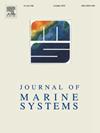德雷克海峡和南极半岛北部碳酸盐岩系统动力学的区域不同驱动因素
IF 2.5
3区 地球科学
Q2 GEOSCIENCES, MULTIDISCIPLINARY
引用次数: 0
摘要
德雷克海峡(DP)和邻近的南极半岛北部(NAP)是南大洋内物理和生物地球化学过程同时影响二氧化碳系统的高度动态区域。海洋总碱度(AT)和总溶解无机碳(CT)是有价值的碳酸钙欠饱和早期指标,有助于评估海洋的缓冲能力。然而,由于缺乏季节代表性和空间变异性,在预测DP和NAP的碳酸盐系统动力学方面仍然存在很大的不确定性。为了解决这一不确定性,我们在区域层面上利用前所未有的两个连续的南方夏季和初秋时期(2003年2月至4月和2004年)的地表数据确定了影响碳酸盐系统的因素。结果表明,受极锋位置和靠近陆地的影响,DP和NAP的AT和CT动态表现为保守和非保守行为。在沿海地区,盐度和陆地影响是主要决定因素,而在海洋地区,营养物和浮游植物生产力发挥了更突出的作用。PF的位置在养分比例上形成了纬度上的优势,建立了碳酸盐化学驱动力的新层次结构,其中硅酸盐在DP和NAP南部的流行程度更高。结果表明,碳酸盐岩系统具有显著的区域差异,从北向南的AT和CT增加,使NAP成为最脆弱的区域,因为酸化和冰融化的加速增长。对海洋酸化的敏感性和碳酸盐系统的季节性波动表明,最南端地区的钙质结构面临更高的风险。本文章由计算机程序翻译,如有差异,请以英文原文为准。
Regionally distinct drivers of the carbonate system dynamics in the Drake Passage and northern Antarctic Peninsula
The Drake Passage (DP) and the adjacent northern Antarctic Peninsula (NAP) are highly dynamic regions within the Southern Ocean where physical and biogeochemical processes simultaneously influence the CO2 system. Ocean total alkalinity (AT) and total dissolved inorganic carbon (CT) serve as valuable early indicators of calcium carbonate undersaturation and help evaluate the buffering capacity of the ocean. However, significant uncertainty remains in predicting carbonate system dynamics in the DP and NAP due to a lack of seasonal representation and the spatial variability. To address this uncertainty, we identified factors affecting the carbonate system at a regional level using unprecedented surface data from two consecutive austral summer and early fall periods (February–April 2003 and 2004). The data revealed that the dynamics of AT and CT in the DP and NAP exhibited both conservative and non-conservative behaviors influenced by the position of the Polar Front (PF), and the proximity to land. In coastal regions, salinity and terrestrial influence were major determinants, while in oceanic regions, nutrients and phytoplankton productivity played a more prominent role. The position of the PF creates a latitudinal edge in nutrient ratios, establishing a new hierarchy of carbonate chemistry drivers where silicate gains prevalence toward the southern DP and NAP. The results highlight significant regional variability in the carbonate system, with increasing AT and CT from north to south, making NAP the most vulnerable region due to accelerated acidification and ice melt-growth. Susceptibility to ocean acidification and seasonal fluctuations in the carbonate system indicate a higher risk to calcareous structures in the southernmost region.
求助全文
通过发布文献求助,成功后即可免费获取论文全文。
去求助
来源期刊

Journal of Marine Systems
地学-地球科学综合
CiteScore
6.20
自引率
3.60%
发文量
81
审稿时长
6 months
期刊介绍:
The Journal of Marine Systems provides a medium for interdisciplinary exchange between physical, chemical and biological oceanographers and marine geologists. The journal welcomes original research papers and review articles. Preference will be given to interdisciplinary approaches to marine systems.
 求助内容:
求助内容: 应助结果提醒方式:
应助结果提醒方式:


